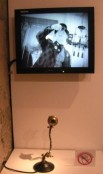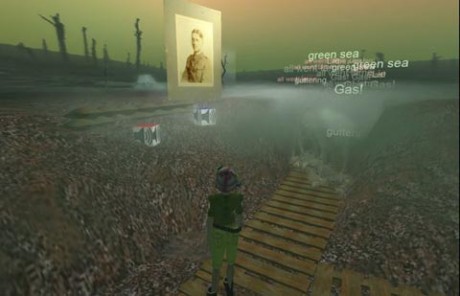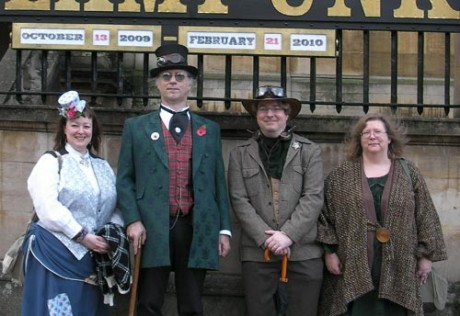Category — Art
& Simpson">“Only Remembered” — Coope Boyes & Simpson
In this video, leading British folk musicians Coope Boyes & Simpson provide the music in their unique and moving acapella style with the song “Only Remembered”, as we view aspects of the unique exhibition by the University of Oxford’s First World War Poetry Digital Archive in the immersive 3D virtual world of Second Life.
The exhibition simulates aspects of life in the trenches on the Western Front during the 1914–1918 war and presents work by the “War Poets” of the period.
As visitors explore the simulation, they can listen to the voices of veterans recounting their experiences of the war, view original film footage and photographs from the time, and learn about life on the Western Front, encountering some of the most powerful poetry in English literature by seeing the original manuscripts, turning the pages of the poets’ war diaries and letters, and listening to readings.
The video is taken from the 10 November 2009 episode of the TV series Designing Worlds, a weekly live show covering design and designers in virtual worlds, produced by Prim Perfect magazine and Treet.TV.
“Only Remembered” (Bonar/Sankey/Tams Voice Publishing) is used by permission and is taken from the album Private Peaceful The Concert (No Masters NMCD24) by Coope Boyes & Simpson.
For more information, read this article on The First World War Poetry Digital Archive in Second Life.
November 14, 2009 Comments Off on “Only Remembered” — Coope Boyes & Simpson
Oxford University’s virtual First World War site opens in Second Life
I’d like to draw your attention to the following press release regarding the opening of the Second Life presence of Oxford University’s First World War Poetry Digital Archive. I was involved in recording some of the audio for this project, including several poetry readings, tutorials and the introduction and epilogue to the installation. More details here; video at foot of this article.
An exciting new project in interactive education will launch on 2nd November 2009, drawing together the resources and expertise of the University of Oxford, and the possibilities for immersion and interactivity offered by the virtual world of Second Life.
The First World War Poetry Digital Archive and the Learning Technologies Group at the University of Oxford have collaborated to bring together a wealth of digitised archival material from the First World War into an environment that allows this powerful material to be explored and experienced in a radically new way.
“The aim of the initiative is to place the poetry of the Great War in context,” explains Stuart Lee, Lecturer in English at the University of Oxford, “It allows the visitors to the exhibition to visualise archival materials in an environment that fosters deeper understandings. Visitors also have the opportunity to take advantage of the social and interactive aspects that the environment offers.”
The project has imported into the Second Life environment a range of digitised archival materials from the major poets of the First World War (including poetry manuscripts, letters and diaries) along with contextual primary source materials. These have been positioned within an environment which has been modelled to represent areas of the Western Front, 1914 — 1918.
The materials have been supplemented with new interpretative content and a spectrum of interactive tools and tutorials, streaming video and audio effects to create a vivid immersive experience that is, according to visitors, deeply moving.
“I had, of course, read about the First World War, and seen archive news footage too,” says Saffia Widdershins, a Second Life resident. “But to have the feeling of walking along narrow trenches on duckboards half covered in mud, to see the dugouts, or to stand in a dressing station, hearing the voices of people who had been there describing their own experiences – this is all incredibly powerful.”
There will be a Second Life Press Launch at 4.30am SLT (12.30 UK time) and again at 2pm SLT (22:00 UK time) on Monday 2nd November. Come to the landing point at: http://slurl.com/secondlife/Frideswide/219/199/646/ and take the TP to Theatre.
The installation will be open for exploration from 2am Monday 2nd November 2009. We ask visitors to preserve the atmosphere of this environment by wearing the clothing provided at the landing area.
November 1, 2009 Comments Off on Oxford University’s virtual First World War site opens in Second Life
Steampunk in Oxford
 This weekend I had the pleasure of spending a day with a colloquy of friends in the venerable University city of Oxford, centred around a visit to the Museum of the History of Science to see their Steampunk Art exhibition.
This weekend I had the pleasure of spending a day with a colloquy of friends in the venerable University city of Oxford, centred around a visit to the Museum of the History of Science to see their Steampunk Art exhibition.
I’d been past this building before – it’s the original home of the Ashmolean – but never inside. Turns out it’s a wonderful little museum on about three floors and a veritable storehouse of ancient scientific instruments of all shapes and size, with an emphasis on brass and the odd bit of mahogany.
The museum would be worth visiting at any time just to take in the development of scientific and technological instruments over the last few hundred years – there are microscopes, telescopes, astrolabes, electrical machines and a great deal more – but it also made the perfect location for the first UK museum exhibit of Steampunk Art, which runs until February 21, 2010. I would recommend a visit if you’re in the area or can arrange to be.
 Steampunk, one could say, is a genre that imagines what might have happened if the technology of the 19th century had not been eclipsed by that of the 20th. It’s Jules Verne and H G Wells’ vision of technology; you also get a certain feeling of it from Oxfordian Philip Pullman’s His Dark Materials trilogy.
Steampunk, one could say, is a genre that imagines what might have happened if the technology of the 19th century had not been eclipsed by that of the 20th. It’s Jules Verne and H G Wells’ vision of technology; you also get a certain feeling of it from Oxfordian Philip Pullman’s His Dark Materials trilogy.
Thus the basement of the Museum is currently filled with all manner of mysterious contraptions with glowing incandescent filaments, whirling (or potentially whirling) mechanisms, and mechanical prosthetics. Some of them are shown in the accompanying photographs.
I was joined by Oxford resident Polly (with whom I work on Designing Worlds), Lynne (my collaborator on the iPhys projects for Sunderland City College) and her husband Richard, and also, at least for part of the day, by Ann and Knick who it was lovely to see again and kindly put me up for the weekend.
 After the exhibition and some refreshment, we took in the last full day of a fascinating exhibition on book-binding at the Bodleian, followed by the open-top bus tour of the city, which is worth the effort. Mid-afternoon we ended up at Blackwells’ where we all seemed to acquire a set of John Grant’s series of science books, Discarded, Corrupted and Bogus Science. We then retired to the coffee shop upstairs to discuss falling standards in British secondary and further education.
After the exhibition and some refreshment, we took in the last full day of a fascinating exhibition on book-binding at the Bodleian, followed by the open-top bus tour of the city, which is worth the effort. Mid-afternoon we ended up at Blackwells’ where we all seemed to acquire a set of John Grant’s series of science books, Discarded, Corrupted and Bogus Science. We then retired to the coffee shop upstairs to discuss falling standards in British secondary and further education.
 In the evening, an excellent dinner at the Trout in Wolvercote.
In the evening, an excellent dinner at the Trout in Wolvercote.
November 1, 2009 Comments Off on Steampunk in Oxford
“…And each slow dusk a drawing down of blinds.”
As readers may know, one of my several activities is audio production, both voice-over work and the production of complete packages with voice, music, effects and so on.
Recently many of these productions have been particularly associated with educational programmes, clients including the British Library and City of Sunderland College. Interestingly, all these projects have resulted from meeting people in the virtual world of Second Life. (Partially as a result, incidentally, I do not have a great deal of time for people who criticise me for “playing” in SL or try to convince me that nothing significant will come of it.)
I have a teaching qualification myself, and I’m particularly interested in the educational possibilities of virtual worlds: Second Life is by far the most popular and widely-used of the virtual worlds currently available, although there is increasing activity in “OpenSim” variants using essentially the same technology.
Most recently I was introduced to some of the staff of the First World War Poetry Digital Archive, based at the University of Oxford. They are on the point of launching (on 2 November) a new region in Second Life (named Frideswide after the patron saint of Oxford) which is home to a painstakingly-built environment designed to shed light on aspects of the life of soldiers in the trenches along the Western Front during the First World War. Students can visit the site and learn not only about the conditions endured by infantrymen during the Great War but also hear poetry from the ‘War Poets’, along with interviews and tutorials.
Here’s how they describe the installation:
This tour of a stylised version of the trench systems in the Western Front has … two objectives:
• to show you the physical context of the trench systems
• to expose items held in the First World War Poetry Digital Archive in a three-dimensional environment…This [is] not an attempt to give you a realistic experience of what it was like to be on the Western Front. The physical depravation, or the chance of serious injury or death, cannot be replicated, and this should always be remembered.
More importantly perhaps, this is but one view of the War – and it would be safe to say this is a view open to discussion. …we have presented rain-sodden trenches, infested by rats, in gloomy surroundings. But this was not always the case. The opening day of the Battle of the Somme, for example, was a beautiful summer’s morning in stark contrast to the depictions we often see of the muddy hell of Paaschendaele.
Chris Stephens, who has been instrumental in putting the simulation together, commissioned me initially to provide an audio version of an A‑level/University-level Tutorial on “Remembrance” along with four poems: Anthem for Doomed Youth by Wilfred Owen, Does It Matter? by Siegfried Sassoon, plus Louse Hunting and Dead Man’s Dump by Isaac Rosenberg.
I’ve now recorded some additional poetry readings – Repression of War Experience, Aftermath, and On Passing the New Menin Gate, all by Siegfried Sassoon; plus 1916 Seen From 1921 and Can You Remember by Edmund Blunden – and an introduction and epilogue.
These poems have a great deal to tell us about the feelings of their authors, and many of them are powerfully moving. Dead Man’s Dump in particular is full of vivid, detailed imagery.
The tutorial, on the other hand, encourages us to ask a number of questions about our conception of what the Great War was like, and uncovers where much of our information has come from. It also challenges some of our assumptions about the conflict. At the time of writing, there are only three veterans of the First World War left alive, so we rely increasingly on indirect sources.
In the Second Life representation, you start off at an army camp and then proceed to the trenches via a floating bubble, during which you hear the introduction to the installation.
Once at ground level in the trenches, you can walk around and visit different aspects of the trench network. Along the way, images of soldiers flicker into view and you might hear an interview or a piece of poetry. The tutorials are accessed via a “HUD” (Head-Up Display) enabling you to proceed through the material and exercises at your own pace. Additional audio extracts are initiated by clicking on loudspeaker symbols.

A scene from the University of Oxford’s First World War representation in Second Life. The visitor is able to walk around in the trenches and ultimately climb a ladder up on to the battlefield itself; the cubes with a loudspeaker symbol on them enable playback of audio material such as poetry readings and interviews. The green-tinged cloud and floating text ahead are part of a section on the use of poison gas during the War.
Overall, the Second Life representation is quite an intense and powerful experience, and I can imagine it will be a particularly effective educational tool.
The challenge for an environment like this is that there is a fairly steep learning curve before visitors can fully experience what a virtual world like Second Life can offer – before you can experience an installation like this you have to learn how to move around, activate things and generally operate successfully in the environment. However in this case you really need to be able to do little more than walk around and click on objects, so most people will require no more than a few minutes of training to be able to get the most out of virtual re-creations like this.
I wish the First World War Poetry Digital Archive every success with this project and am very pleased to have been able to make a small contribution to it. This installation will also be featured in the 10 November edition of the Designing Worlds show on Treet.TV.
*“…And each slow dusk a drawing down of blinds.” is the final line of Anthem for Doomed Youth by World War I poet Wilfred Owen – one of the WWI poems I’ve recorded for this project. Photos courtesy of First World War Poetry Digital Archive.
October 26, 2009 Comments Off on “…And each slow dusk a drawing down of blinds.”


